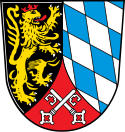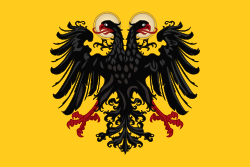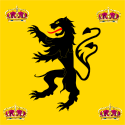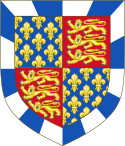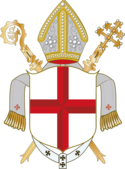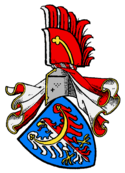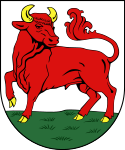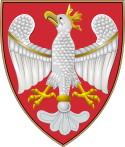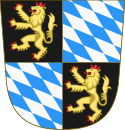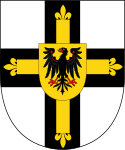Hussitterkrigene
| Hussitterkrigene | |||||
|---|---|---|---|---|---|
| Del af De europæiske religionskrige og korstogene | |||||
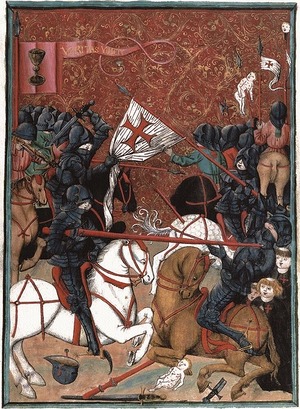 | |||||
| |||||
| Parter | |||||
| De bøhmiske krige (1419–20)
|
En splittet gruppe af Taboritter: | ||||
| Ledere | |||||
Allierede under den polske hussitterinvation af Preussen:
Support:
|
Adam Rohan | ||||
hussitterkrigene, også kaldt bøhmerkrigene eller hussitterrevolutionen, var en serie af krige, der blev udkæmpet mellem kristne hussitter og den samlede kristne katolske styrke under kejser Sigismund og pave Martin 5., europæiske monarker, der var loyale mod den katolske kirke samt forskellige fraktioner af hussitterne. Efter de første sammenstød skiftede utraquisterne side i 1423 og kæmpede sammen med den romerskkatolske kirke mod taboritteren og andre hussitter-fraktioner. Krigene varede fra omkring 1419 og frem til 1434.
Urolighederne begyndte efter den præ-protestantiske reformmand Jan Hus blev henrettet af den katolske kirke i 1415 for kætteri.[1][2] Den bøhmiske konge, Wenzel 4., havde planer om at blive kronet som tysk-romersk kejser, og han undertrykte hussitternes religion, der alligevel fortsatte med at blive udbredt.[3] Da kong Wenzel 4. døde af naturlige årsager få år senere blev spændingerne med hussitterne større. I Prag og forskellige andre del af Bøhmen blev de katolske tyskere, som boede der, tvunget ud.
Wenzels bror, Sigismund, der havde arvet tronen, blev forarget over at hussitterismen fortsat spredte sig.[3] Han fik tilladelse fra paven til at igangsætte et korstog mod hussitterne. Store mængde korsfarere fra hele Europa kom for at slutte sig til Sigismund og kæmpe mod hussitterne. Prag blev angrebet og herefter forladt. Hussitterne belejrede efterfølgende korsfareres garnison, og de tilbageerobrede næsten alle de områder, som de havde mistet, hvilket resulterede i at korstoget var en total fiasko.
Efter kommandoen over hæren blev overdraget til yeoman Jan Žižka, fulgte interne stridigheder blandt hussitterne. Tyskerne så at deres modstander var svækket, og de igangsatte endnu et korstog. De led dog et voldsomt nederlag til Žižka under slaget ved Deutschbrod, og de blev atter drevet bort. Pavestolen forsøgte sig med et tredje korstog, men det resulterede i endnu en fiasko. Lithauerne og polakkerne ønskede ikke at angribe tjekkerne, og tyskerne havde interne konflikter, så de kunne ikke samle nok tropper til at kæmpe mod hussitterne. Kongen af Danmark forlod også den tjekkiske grænse for at vende hjem. Tyskerne blev til sidst tvunget til at søge fred.
Kampene sluttede efter 1434, hvor den moderate utraquist-fraktion af hussitterne besejrede de radikale taboritter. Hussitterne indvilligede i at underkaste sig Kongeriget Böhmen og den romersk-katolske kirke, og de fik til gengæld lov at udføre deres lidt anderledes ritualer.
Hussittersamfundet inkluderede størstedelen af den tjekkiske befolkning i Kongeriget Böhmen, og de udgjorde en stor spontan militærmagt. De besejrede fem på hinanden følgende korstog der blev udskrevet mod dem af pave Martin 5. (1420, 1421, 1422, 1427, 1431), og de intervenerede i krige i de omkringliggende lande. Hussitterkrigene er kendt for deres store brug af tidlige håndholdte skydevåben som hagebøsser.
Referencer
- ^ Kuhns, Oscar (1907). John Huss : The Witness. New York Public Library: Cincinnati : Jennings and Graham ; New York : Eaton and Mains.
- ^ Shahan, Thomas Joseph (1913). Catholic Encyclopedia, Volume 4.
- ^ a b Lützow, Francis (1914). The Hussite Wars. University of Toronto Library: London : Dent, New York : Dutton.
Eksterne henvisninger
- [Hussite Museum in Tábor][1]
- Joan of Arc's Letter to the Hussites (23 March 1430) — In 1430, Joan of Arc dictated a letter threatening to lead a crusading army against the Hussites unless they returned to "the Catholic Faith and the original Light". This link contains a translation of the letter plus notes and commentary.
- Tactics of the Hussite Wars Arkiveret 18. oktober 2019 hos Wayback Machine
- The Bohemian War (1420–1434)
- Jan Hus and the Hussite Wars on Medieval Archives Podcast
Medier brugt på denne side
Flag of Austria with the red in the Austrian national colours which was official ordered within the Austrian Armed Forces (Bundesheer) in the characteristic “Pantone 032 C” (since May 2018 the Red is ordered in the characteristic “Pantone 186 C”.)
Forfatter/Opretter: J a1, Licens: CC BY-SA 3.0
Banner of Kazimierz, duke of Pomerania - Szczecin in battle of Grunwald (1410)
Forfatter/Opretter: Nomadic1, Licens: CC BY-SA 4.0
Coat of arms of the Roman Catholic Diocese of Würzburg
Forfatter/Opretter: Peter Loeser and Eugene Ipavec, Licens: CC BY-SA 3.0
During the Hussite Wars when the City of Prague was attacked by "Crusader" and mercenary forces, the city militia fought bravely under this banner. It was later captured by Swedish troops on their raid in 1649 and eventually placed in the Royal Military Museum in Stockholm; today it is simply called the "Prague Banner." Although this flag still exists, it is in very poor condition. When the Banner was first made and used is open for debate, but earliest evidence indicates that a gonfalon with some municipal charge painted on it was used for Old Town as early as 1419. Eva Turek dates this flag to about 1530 based on the style of characters, painted bordure, and fleurs-de-lis stenciled on it. Since this particular municipal militia flag was used before 1477 and during the Hussite Wars, it is the oldest still preserved municipal flag in Bohemia.
Coat of arms of Brandenburg. Argent, an eagle gules, beaked, armed, clover-stemmed or.
Erb Jana Žižky z Trocnova.
Forfatter/Opretter: User:Sodacan, wheel from File:Coat of Arms of Ernest August, Duke of Brunswick-Lüneburg (1661-1692).svg, Licens: CC BY-SA 3.0
Banner of the Arms of the Electorate of Mainz
Hussite banner based on the illuminations of the Jena Codex and the Göttingen Codex, 15th century
Black_St_George's_Cross
Used by Archbishopric-Electorate of Cologne 1475-1794 (Erzbistum Köln)
Forfatter/Opretter: Atillak, Licens: CC BY-SA 2.5
Erb Jana Roháče z Dubé podle pečeti u listu, jímž v roce 1421 vyhlašuje nepřátelství Oldřichovi z Rožmberka.
Banner of Kingdom of Poland in the 14th century
A seal of Duke Premislaus II from 1290 shows the ruler holding a banner emblazoned with a crowned eagle. During the reign of King Ladislaus (r. 1320–1333), the red cloth with the White Eagle was established as the royal banner. The orientation of the eagle on the banner varied; its head could point either upwards or towards the hoist.
Flag of the Papal States before 1808.
(c) Heralder, CC BY-SA 3.0
Arms of Sigismund, Holy Roman Emperor.
Scheibler'sches Wappenbuch , älterer Teil; Seite 414
Die Herrn von Liechtenburg
(Böhmen)Flag of the State of the Teutonic Order
Forfatter/Opretter: David Liuzzo, eagle by N3MO, Licens: CC BY-SA 3.0
Banner of the Holy Roman Empire, double headed eagle with halos (1400-1806)
Forfatter/Opretter: ThecentreCZ, Licens: CC BY-SA 4.0
Coat of arms of Bohemian Crown in Österreich-Ungarn Monarchy.
After 1900 a special banner for the crown prince, titled Markgraf von Meissen [margrave of Meissen], was issued, showing a black lion (for the palatinate of Meissen) among four royal crowns in the corners. Other princes used only the lion.
Forfatter/Opretter: Dragovit, derived from the work Sirotci 2.jpg, Licens: CC BY-SA 4.0
Rectagular version of the standard used by Bohemian Orebites, later renamed to Orphans (Czech: Sirotci), the hussite faction of the 15th century.
Forfatter/Opretter: unknown, Licens: Attribution
Forfatter/Opretter: Sodacan, Licens: CC BY-SA 3.0
Arms of John Beaufort, 1st Earl of Somerset. Blazon of the Arms of Beaufort family, Earls and Dukes of Somerset:[1] Quarterly, 1st & 4th: Azure, semé fleurs de lis or (France); 2nd & 3rd: Gules, three lions passant guardant in pale or (England); all within a bordure compony argent and azure.
Forfatter/Opretter: Cornelis; SVG Conversion by: David Liuzzo, Licens: CC BY-SA 2.5
Coat of arms of the Archduchy of Austria
Forfatter/Opretter: originally Alex K, Licens: CC BY-SA 3.0
Prawdopodobny wygląd chorągwi księcia Zygmunta Korybutowicza pod Grunwaldem
Forfatter/Opretter: Samhanin, Licens: CC BY-SA 3.0
Banner of the Margraviate of Moravia
Forfatter/Opretter: David Liuzzo, Licens: Attribution
Wappen des Kurfürstentums und Erzstiftes bzw. Fürsterzbistums
TrierAnachronistic representation of the royal banner of the 12th(?) or 13th to early 15th centuries.
The banner of this period would be square in shape. The heraldic eagle is here shown in early modern style.
The black eagle in a golden field was the ensign of the German kings (as opposed to the emperor) in the 12th and 13th century, but in the 14th century, it was gradually re-interpreted as representing the empire. An early reference to such a banner as "imperial" is made in an account of the burial of Charles IV (d. 1378), as der schwartz adler des richs in einem guldin veld .Forfatter/Opretter: Samhanin, Licens: CC BY-SA 3.0
Coat of arms of the Serbian Despotate (Rascia) from Western Armorials. This particular COA is from an Armorial by Christoph Silberysen (1576).
Red_St_George's_Cross
Used by Archbishopric-Electorate of Trier 898–1794 (Erzbistum Trier)
Wappenbuch des Heiligen Römischen Reiches - BSB Cod.icon. 390 Nürnberg um 1554 - 1568
Forfatter/Opretter: Adolf Matthias Hildebrandt , Licens: CC0
Wappen der Kolowrat (tschechisch Kolovratové, auch Krakovští z Kolovrat), eines böhmischen Uradelsgeschlechts mit gleichen Vorfahren wie die Herren und Reichsgrafen Sahrer von Sahr, auch: Schdiar von Schdiar, gelegentlich auch von Saar, tschechisch: Žďárští ze Žďáru und alttschechisch: Zdiárský ze Zdiáru, lateinisch: de Sora oder de Sara, die Herren von Janovic (deutsch von Janowitz) oder die Herren von Vimperk (deutsch von Winterberg). Verwandtschaft besteht auch mit den Rittern und Grafen Čejka von Olbramovic (deutsch Czejka von Olbramowitz) sowie mit den Rittergeschlechtern Dvořecký von Olbramovic (deutsch Dvoretzky von Olbramowitz), Podolský von Olbramowitz und Zrucký von Chřenovic. → [1]
Forfatter/Opretter: Michelangelo2204, Licens: CC BY-SA 4.0
Coat of Arms of the old Bohemian noble family " ze Šternberka ", counts of Sternberg. Right arms, with right crest
Formal flag of the Silesian Voivodeship
Forfatter/Opretter: Kaiser Torikka+elements from the work of Sodacan, Licens: CC BY-SA 3.0
Coat of arms of Brunswick-Lüneburg Blazon: Per pale, I Gules two lions passant guardant Or (for Brunswick), II Or a semy of hearts Gules a lion rampant Azure (for Lunenburg)
Coat of arms of Olomouc diocese
COA of Gediminaičiai dynasty Lithuania
Coat of arms of the czech city Cheb
Forfatter/Opretter: Poznaniak, Licens: CC BY-SA 2.5
Coat of arms of the Lower Silesian Piasts, used by Duke of Sagan
County of Kłodzko coat of arms
Coat of Arms of Cymburg
Forfatter/Opretter: Sir Iain, Elemens by User:Sodacan, Licens: CC BY-SA 3.0
This SVG file was uploaded with Commonist.
Идущий по зеленной поляне червленый бык на серебряном поле, смотрящий назад и вооруженный золотыми копытами и рогами.
Coat of arms of the Holy See with gold key in bend as described in Donald Lindsay Galbreath, A Treatise on Ecclesiastical Heraldry (W. Heffer and Sons, 1930), p. 9; Bruno Bernhard Heim, Heraldry in the Catholic Church: Its Origin, Customs and Laws (Van Duren 1978 ISBN 9780391008731), p. 54; Heraldry Society of Great Britain; Michel Pastoureau, "Keys" in Philippe Levillain, The Papacy: An Encyclopedia (Routledge 2002 ISBN 9780415922302), vol. 2, p. 891.
Forfatter/Opretter: Samhanin, Licens: CC BY-SA 3.0
Royal banner of the Kingdom of Bohemia (1305)
Reconstruction of the coat of arms from the reverse of majestic seal of the King of Poland – Przemysł II from 1295
Forfatter/Opretter: Adolf Matthias Hildebrandt , Licens: CC0
Stammwappen der Herren von Rosenberg (tschechisch Páni z Rožmberka, Plural Rožmberkové), im 15. Jh. einflussreichstes Adelsgeschlecht in Böhmen, dem Geschlecht der Witigonen entstammend, erloschen 1611.
Forfatter/Opretter: Sir Iain, Elemens by User:Sodacan, Licens: CC BY-SA 3.0
This SVG file was uploaded with Commonist.
Forfatter/Opretter: Ipankonin, Licens: CC BY-SA 3.0
Coat of arms of the Grand Masters of the Teutonic Knights.
Blazon: Argent, on a cross sable a cross floretty Or and overall on an inescutcheon Or an eagle displayed sable.[1]Forfatter/Opretter: Gambo7, Licens: CC BY-SA 3.0
Coat of arms of Papal States
Forfatter/Opretter: Лобачев Владимир, Licens: CC BY-SA 3.0
Coat of Arms seal with Sigismund Kęstutaitis from 1432
Forfatter/Opretter: Samhanin, Licens: CC BY-SA 3.0
Banner of the Duchy of Silesia (16th century - 17th century)
Forfatter/Opretter: Odejea, Licens: CC BY-SA 3.0
Armoiries du pape Martin V : De gueules à la colonne d'argent couronnée d'or.
Source du blasonnement : http://www.araldicavaticana.com/pmartino05.htm Héraldique vaticane
Figures utilisées : et
et Forfatter/Opretter:
- Armoiries_électeur_Brandebourg.svg: Odejea
- derivative work: Amber and Black (talk)
Flag of w:Margraviate of Brandenburg / Electorate of Brandenburg / w:Brandenburg-Prussia 1340-1657
Forfatter/Opretter: Dragovit, Licens: CC BY-SA 4.0
Rectagular version of the standard of Bohemian hussite faction called the Taborites (Czech: Táborité or Táboři) of 15th century.

